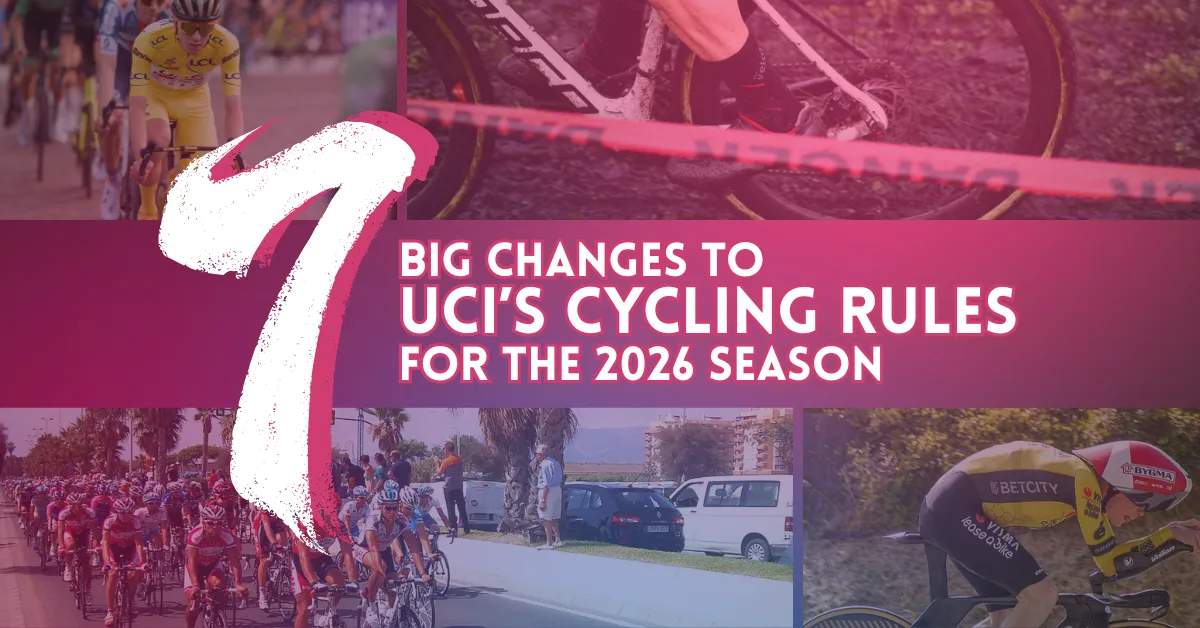When you’re watching the Tour de France or another race, you might be intrigued by how easy it is for these riders to go at such incredible speeds, and how optimized their body positions look on the bike. Part of the answer lies in something that might surprise you: wind tunnels.
Wind tunnels may be more commonly associated with designing airplanes and race cars, but they’ve also become essential tools in the cycling world. But do they actually work? And why do so many top teams and riders seem obsessed with them these days?

A simple matter of air resistance.
When a cyclist races at high speeds, typically above 25 miles per hour, the biggest obstacle they face isn’t hills, rough roads, or even tired legs. It’s the air itself.
At racing speeds, air resistance accounts for 80% to 90% of all the energy a cyclist must expend to keep moving forward. That’s a lot! This means that most of the power they created by pedaling goes toward simply pushing through the air rather than actually propelling the bike forward on the pavement.
Have you ever stuck your hand out of a car window at highway speeds? You can probably feel the tremendous force of the wind pushing against it, much faster than if you were cruising down the street in a residential area. That’s the difference between the pros and the average biking beginner, or even intermediate rider. If you imagine your entire body acting as that hand against the wind, you can understand why professional cyclists obsess over making themselves as aerodynamic as possible.
Embed from Getty ImagesFor aerodynamics, which measurements matter most? The frontal area the rider presents to the wind is a big factor, as well as how aerodynamically shaped they are. They want the air to be able to pass as easily as possible around them. But unlike something designed to move through the wind, like an airplane wing with a sleek and streamlined shape, a cyclist’s body is initially quite blocky and non-aerodynamic shape. It’s challenging to optimize, and that’s where the wind tunnels come in.
Wind tunnel gains can seem anything but marginal.
Cycling fans were pretty surprised to learn that since signing his new contract with Red Bull Bora-Hansgrohe, the time trial superstar Remco Evenepoel has already spent a whopping FIFTEEN HOURS in the wind tunnel already in preparation for 2026. Considering that at this point some post-Tour criteriums are still wrapping up for the year, this amount of time in aero training can start to seem like overkill!
But when pro teams take their riders to wind tunnels for optimization, the results can be pretty dramatic. A typical testing session might reduce a rider’s air resistance by 5% to 15%, which translates to saving around 15 to 30 watts of power. If you need 35 fewer watts of effort to go forward, that’s a huge improvement for most riders.
Embed from Getty ImagesThis really comes into play for time trial events, where cyclists are riding along against the clock, and these super small improvements can actually decide the winner. Forget strategy: you just have to put out more watts and be more aerodynamic than the competition, and you’ve won. So a mere 2% reduction in air resistance might shave 30 seconds off a 40k TT, which can be decisive for the win (or at least between top ten and a mediocre finish).
What about the financial side? It’s a bit interesting too. Wind tunnel testing isn’t cheap, and depending on where teams go, it can cost upward of $900 per hour. But the performance gains might exceed what you’d get from purchasing expensive new equipment. A two-hour session costing around $1,800 that saves 30 watts provides a much better value than buying a $10,000 state-of-the-art wheelset that might only save 5 watts.
This is why top teams consider wind tunnel testing not just worthwhile, but essential.
What does wind tunnel testing really look like?
Cycling wind tunnels are designed to create perfectly smooth, controlled airflow. Most use a “suck-through” design. Here, air gets pulled past the rider from behind, rather than blown at them from the front. This creates a much more stable condition that allows training staff to be certain that any changes in measurements are due to the rider’s position or equipment, not turbulence in the air itself.
The bicycle is mounted on a stationary trainer connected to ultra-precise scales that measure the forces acting on the rider and bike. Many facilities project real-time data directly onto the floor in front of the cyclist. This gives insight into exactly how aerodynamic they are at any given moment. Using this type of immediate feedback, coaches can make quick adjustments, raising or lowering the rider’s head position or tweaking their body angle to find the optimal posture.
Importantly, the rider is actually pedaling during the test, just like they would be when riding alone in a time trial. Testing just the bike alone, or the rider sitting on the bike without moving, produces meaningless results. This is because the rider’s body and pedaling motion create air disturbances that can dramatically affect the overall aerodynamics.
How top teams will be using wind tunnels ahead of the 2026 season.
Aside from Evenepoel, who else will be spending time in the wind tunnel this offseason? The world’s best cycling teams have made wind tunnel testing a mandatory part of their preparation. Teams like Visma Lease-a-Bike, INEOS, and UAE Team Emirates regularly book time at facilities. Most of these testing centers are specific to sport and run by engineers with backgrounds in Formula 1 racing. This brings some motorsport-level precision to cycling.
But if you have the budget to do extensive wind tunnel work, why not? This year, we’d also expect to see Red Bull and Decathlon, who are sporting a new increased budget for the coming season, spending some extra time optimizing their riders for the best possible performance.
In addition to optimizing riders, keep in mind that teams can use wind tunnel testing as a validation tool to confirm whether new equipment, like a different helmet or aerodynamic jersey, actually provides a measurable benefit or is a hinderance against the wind.
A team can also use the wind tunnels as a group. This is primarily useful to test rider configurations for team time trials, where multiple cyclists race together in a line. VLAB attributes their TTT win at the 2019 Tour de France to testing beforehand in the wind tunnel, along with advanced group aerodynamic simulations assisted by computer.
So are wind tunnels the real deal?
Despite their proven value, wind tunnels have some limitations. And critics of wind tunnels in the cycling world typically question their real-world relevance, even in solo efforts like a time trial.
The fundamental problem is that wind tunnels create idealized conditions. These conditions, while perfect for tweaking the body’s ideal position on the bike, don’t fully match what happens during actual races.
In a wind tunnel, the air flows steadily and uniformly in one direction. On the road, wind constantly changes direction and intensity. Crosswinds, when the wind hits the cyclists from the side, are particularly important, because they dramatically affect aerodynamics on the bike.
Embed from Getty ImagesDifferent equipment also performs differently depending on the angle of the wind. For example, deep wheels can actually help push a rider forward in certain crosswind conditions, but they can also become difficult to handle in gusts. So teams sometimes choose slightly less aerodynamic but more stable equipment because the predictability matters more than marginal gains when the wind is swirling.
If this is the case, does the wind tunnel tell the whole story? Not really.
Another challenge involves the rider themselves and their physical form. The perfect aerodynamic position identified in the wind tunnel is typically extremely low and compact. It is also physically demanding and difficult to maintain. The amount of core strength and flexibility a cyclist may need for their perfect aero position may be too much. If a rider can’t hold that position for an entire race, the wind tunnel data becomes useless as they’ll eventually sit up higher due to fatigue.
Pro cyclists do train their core muscles through exercise (like doing planks) to build up the strength needed to maintain the most aerodynamic position possible for hours at a time. But even for the most physically fit riders who can hold their position without problem, there’s always the potential of injury, or a race situations that requires riders to sit up. In these cases, all the wind tunnel training might go down the drain.
Using wind tunnels in tandem with new technology.
Recognizing these limitations, pro cyclists don’t rely only on the wind tunnel to help them get aero. In fact, some complementary technologies and approaches (and some that are quite cutting edge) can help with aerodynamic optimization.
The first comes with making the gear used, like the bike or even clothing, as aerodynamic as possible without the wind tunnel. Computer simulations can allow manufacturers to virtually test thousands of designs before making their physical prototypes. In a virtual wind tunnel setup, a rider and their bike can be scanned, then their aero position is simulated. This is much more affordable than the cost of physical testing, typically around $175 to $250 per scan.
While simulations can’t perfectly model everything, especially factors like fabric behavior, they’re still a useful alternative. Teams may use them to screen gear or kit options before committing to expensive wind tunnel time.
Testing aerodynamics outside of the tunnel.
Indoor velodromes are another controlled environment where riders can measure their aerodynamics at race speed. But even inside the velodrome, the conditions don’t really match up to real racing.
The most exciting development are portable sensors that can mount to the bike and measure aerodynamics in real-time during actual rides. Devices that can calculate air resistance moment by moment also display the results on the bike computer for riders to take a look. When using these tools, riders can practice maintaining their optimal position during training rides… yes, even in crosswinds or other outdoor conditions!
Embed from Getty ImagesThese types of tools are becoming more reliable, accurate, and widely available to pros. We may see wind tunnel testing become less popular in the future, with more teams and riders reliant on these approaches for in-field optimization rather than static testing.
The bottom line: wind tunnels do work, but only as part of a larger plan.
So do wind tunnels actually help professional cyclists optimize? Absolutely! We’re not just talking about marginal gains, because 30 watts can make a difference in a race result. Besides, the universal adoption by teams at the top level is good evidence for the wind tunnel’s value.
However, understanding the wind tunnel’s role still takes some nuance.
Ultimately, the greatest single source of aerodynamic improvement is the rider’s body position. It accounts for the vast majority of air resistance. Beyond equipment, it’s what the rider can change to become more efficient. And the best equipment in the world can’t compensate for poor positioning. The wind tunnel is more valuable not just for its measurements, but for giving riders concrete, quantifiable feedback. Knowing that a specific position saves 10 watts provides motivation to train holding that position throughout an entire race.
But what if new tech replaces the wind tunnel and can still give the riders that actionable feedback? The wind tunnel may be left to cycling history.
Winning races requires constant progress and technical improvement.
Pro racing is fundamentally a sport where physiology undergoes some engineering. How many teams and riders love wind tunnel testing represents this, because it’s currently one of the best ways to engineer the body. But it’s not perfect, and certainly not the only answer for all time.
For now, the wind tunnel is indispensable. The world’s best cyclists use it to continue to push the boundaries of their performance, and it works. But let’s wait and see what comes next!
Embed from Getty ImagesDo you think pros will keep using the wind tunnel for the foreseeable future? Or do you think this will eventually get replaced by new technology? Let us know in the comments or on social media! ★










Leave a Reply